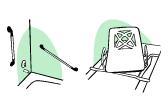
For those with a mobility impairment, the right hardware and enhancements can make all the difference to how easy it is to get into and out of bathtubs.
Getting in and out of a bath when you’re not fully mobile can be a difficult and dangerous proposition. Slips and falls in the tub can cause serious injuries or even death. Thankfully, there are many different bathtub enhancements which allow people with disabilities to bathe without assistance. These include grab bars, non-slip surfacing, seating and specially designed baths such as walk-in tubs.

Grab rails
A grab rail (or grab bar) allows a person to safely lower themselves into a bathtub and get out again, giving them something to hold onto. Depending on the situation, two or even three grab rails may be required at differing angles. Most grab rails are installed horizontally, vertically or at right angles to the bath. For corner baths, grab rails are are normally installed across the walled side and head of the bath tub at around waist height. For island bathtubs (i.e. those which join the wall only on one side), rails need to protrude further from the wall and may need to be affixed at four points rather than two.
Grab rails come in a range of diameters to provide for different uses and purposes, with 32mm the most commonly used diameter. It is highly important that grab rails are installed correctly so that they don’t pull off the wall and cause the very accident they are designed to prevent. Grab bars should be installed by experienced installers, and should be attached to a wall stud. Temporary rails are also available, however these should be used with extreme caution, as if they’re not properly affixed they can do far more damage than good.
Easy to use taps
The right taps will make the bath easier to control, especially if the person using it has limited function or soreness in their fingers, thumbs or wrists. A single handle mixer tap can be controlled using a single paddle, which is lifted and lowered to control water flow, and twisted from side to side to control temperature. This kind of tap can easily be controlled using just about any part of the body and can’t be closed too tightly, and is therefore useful for those with arthritis or another ailment that might affect their ability to twist a tap.
Non-slip surfacing
Non-slip surfacing treatments come standard in the base of many modern tubs, and are designed to prevent falls when standing in soapy water. If you don’t have any, it can be as easy as placing a non-slip rubber mat in the base of the bath. More permanent solutions include self-adhesive strips which can be placed at strategic locations in the bath and surrounding area.
Bath seats
Seating for baths is best achieved at the design stage – that is, your best option is to buy a tub with a seat designed into it. Rare in baths other than walk-in tubs, seating can nevertheless be moulded into the walls of the tub, and can also act as a step. While non-permanent seating is available for baths in the form of portable bath boards and bath benches, they are generally not highly recommended, as they can easily slide out from underneath the bather and cause considerable harm.
Another more expensive option is to install a bath lift, also known as a tub lift. These systems feature a chair that can be raised and lowered into the tub.
Walk-in bathtubs
Walk-in tubs are very different to standard tubs. They are often designed as ‘upright’ tubs (as opposed to tubs you lie in), have seats moulded into them and have a door in one wall to allow entry and exit. A bather enters through the door, then closes it, takes a seat and fills the bath from the inside. Some walk-in tubs are also closer to the conventional horizontal tub design, simply doing away with the need to step over the tub wall.
Different designs will have either an inward opening door or an outward opening door. An inward opening door means that there need be no thought given to clearance for the door outside the tub, although this type of tub needs to be larger inside to accommodate for the door. Outward opening doors mean the bath can be smaller. It’s worth remembering that a walk-in bath with an inward opening door cannot be opened unless all the water is fully drained out, due to the pressure the water creates on the door. In an emergency, this could prove to be troublesome.





